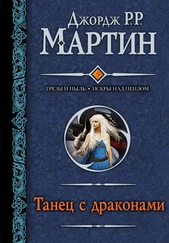Late in the year 45 AC, King Maegor took the field once again to continue his war against the outlawed remnants of the Faith Militant, leaving Queen Tyanna to rule King’s Landing together with the new Hand, Lord Edwell Celtigar. In the great wood south of the Blackwater, the king’s forces hunted down scores of Poor Fellows who had taken refuge there, sending many to the Wall and hanging those who refused to take the black. Their leader, the woman known as Poxy Jeyne Poore, continued to elude the king until at last she was betrayed by three of her own followers, who received pardons and knighthoods as their reward.
Three septons traveling with His Grace declared Poxy Jeyne a witch, and Maegor ordered her to be burned alive in a field beside the Wendwater. When the day appointed for her execution came, three hundred of her followers, Poor Fellows and peasants all, burst from the woods to rescue her. The king had anticipated this, however, and his men were ready for the attack. The rescuers were surrounded and slaughtered. Amongst the last to die was their leader, who proved to be Ser Horys Hill, the bastard hedge knight who had escaped the carnage at the Great Fork three years earlier. This time he proved less fortunate.
Elsewhere in the realm, however, the tide of the times had begun to turn against the king. Smallfolk and lords alike had come to despise him for his many cruelties, and many began to give help and comfort to his enemies. Septon Moon, the “High Septon” raised up by the Poor Fellows against the man in Oldtown they called the High Lickspittle, roamed the riverlands and Reach at will, drawing huge crowds whenever he emerged from the woods to preach against the king. The hill country north of the Golden Tooth was ruled in all but name by the Red Dog, Ser Joffrey Doggett, self-proclaimed Grand Captain of the Warrior’s Sons. Neither Casterly Rock nor Riverrun seemed inclined to move against him. Dennis the Lame and Ragged Silas remained at large, and wherever they roamed, smallfolk helped keep them safe. Knights and men-at-arms sent out to bring them to justice oft vanished.
In 46 AC, King Maegor returned to the Red Keep with two thousand skulls, the fruits of a year of campaigning. They were the heads of Poor Fellows and Warrior’s Sons, he announced, as he dumped them out beneath the Iron Throne…but it was widely believed that many of the grisly trophies belonged to simple crofters, fieldhands, and swineherds guilty of no crime but faith.
The coming of the new year found Maegor still without a son, not even a bastard who might be legitimized. Nor did it seem likely that Queen Tyanna would give him the heir that he desired. Whilst she continued to serve His Grace as mistress of whisperers, the king no longer sought her bed.
It was past time for him to take a new wife, Maegor’s counselors agreed…but they parted ways on who that wife should be. Grand Maester Benifer suggested a match with the proud and lovely Lady of Starfall, Clarisse Dayne, in the hopes of detaching her lands and house from Dorne. Alton Butterwell, master of coin, offered his widowed sister, a stout woman with seven children. Though admittedly no beauty, he argued, her fertility had been proved beyond a doubt. The King’s Hand, Lord Celtigar, had two young maiden daughters, thirteen and twelve years of age respectively. He urged the king to take his pick of them, or marry both if he preferred. Lord Velaryon of Driftmark advised Maegor to send for his niece Rhaena, the widow of Aegon the Uncrowned. By taking her to wife, Maegor could unite their claims, prevent any fresh rebellions from gathering around her, and acquire a hostage against any plots her mother, Queen Alyssa, might foment.
King Maegor listened to each man in turn. Though in the end he scorned most of the women they put forward, some of their reasons and arguments took root in him. He would have a woman of proven fertility, he decided, though not Butterwell’s fat and homely sister. He would take more than one wife, as Lord Celtigar urged. Two wives would double his chances of getting a son; three wives would triple it. And one of those wives should surely be his niece; there was wisdom in Lord Velaryon’s counsel. Queen Alyssa and her two youngest children remained in hiding (it was thought that they had fled across the narrow sea, to Tyrosh or perhaps Volantis), but they still represented a threat to Maegor’s crown, and any son he might father. Taking Aenys’s daughter to wife would weaken any claims put forward by her younger siblings.
After the death of her husband and her flight to Fair Isle, Rhaena Targaryen had acted quickly to protect her daughters. If Prince Aegon had truly been the king, by law his eldest daughter, Aerea, stood his heir, and might therefore claim to be the rightful Queen of the Seven Kingdoms…but Aerea and her sister, Rhaella, were barely a year old, and Rhaena knew that to trumpet such claims would be tantamount to condemning them to death. Instead, she dyed their hair, changed their names, and sent them from her, entrusting them to certain powerful allies, who would see them fostered in good homes by worthy men who would have no inkling of their true identities. Even their mother must not know where the girls were going, the princess insisted; what she did not know she could not reveal, even under torture.
No such escape was possible for Rhaena Targaryen herself. Though she could change her name, dye her hair, and garb herself in a tavern wench’s roughspun or the robes of a septa, there was no disguising her dragon. Dreamfyre was a slender, pale blue she-dragon with silvery markings who had already produced two clutches of eggs, and Rhaena had been riding her since the age of twelve.
Dragons are not easily hidden. Instead the princess took them both as far from Maegor as she could, to Fair Isle, where Marq Farman granted her the hospitality of Faircastle, with its tall white towers rising high above the Sunset Sea. And there she rested, reading, praying, wondering how long she would be given before her uncle sent for her. Rhaena never doubted that he would, she said afterward; it was a question of when, not if .
The summons came sooner than she would have liked, though not as soon as she might have feared. There was no question of defiance. That would only bring the king down on Fair Isle with Balerion. Rhaena had grown fond of Lord Farman, and more than fond of his second son, Androw. She would not repay their kindness with fire and blood. She mounted Dreamfyre and flew to the Red Keep, where she learned that she must marry her uncle, her husband’s killer. And there as well Rhaena met her fellow brides, for this was to be a triple wedding.
Lady Jeyne of House Westerling had been married to Alyn Tarbeck, who had died with Prince Aegon in the Battle Beneath the Gods Eye. A few months later, she had given her late lord a posthumous son. Tall and slender, with lustrous brown hair, Lady Jeyne was being courted by a younger son of the Lord of Casterly Rock when Maegor sent for her, but this meant little and less to the king.
More troubling was the case of Lady Elinor of House Costayne, the wife of Ser Theo Bolling, a landed knight who had fought for the king in his last campaign against the Poor Fellows. Though only nineteen, Lady Elinor had already given Bolling three sons when the king’s eye fell upon her. The youngest boy was still at her breast when Ser Theo was arrested by the Kingsguard and charged with conspiring with Queen Alyssa to murder the king and place the boy Jaehaerys on the Iron Throne. Though Bolling protested his innocence, he was found guilty and beheaded the same day. King Maegor gave his widow seven days to mourn, in honor of the gods, then summoned her to tell her they would marry.
At the town of Stoney Sept, Septon Moon denounced King Maegor’s wedding plans, and hundreds of townfolk cheered wildly, but few others dared to raise their voices against His Grace. The High Septon took ship at Oldtown, sailing to King’s Landing to perform the marriage rites. On a warm spring day in the 47th year After the Conquest, Maegor Targaryen took three wives in the ward of the Red Keep. Though each of his new queens was garbed and cloaked in the colors of her father’s house, the people of King’s Landing called them “the Black Brides,” for all were widows.
Читать дальше




![Джордж Мартин - Сыны Дракона [лп]](/books/33039/dzhordzh-martin-syny-drakona-lp-thumb.webp)







